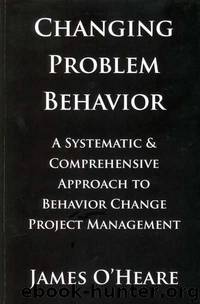Changing Problem Behavior by James O'Heare

Author:James O'Heare
Language: eng
Format: mobi, epub
Tags: Training, Animal Care & Pets, ebook, Hobbies & Home, Dogs, Education & Reference, Crafts, Pets & Animal Care
ISBN: 9781617810404
Publisher: Dogwise
Published: 2010-04-21T21:00:00+00:00
2. constructing and implementing the behavior change program
3. maintenance of the behavior.
The product of the functional assessment is the contingency statement and information regarding other significant variables or implications of the problem behavior for the family. That is, we are tasked with identifying:
• the behavior of concern, including a suitable measure for it
• any function-altering stimuli that may share control of the behavior
• the discriminative stimulus that evokes the behavior
• the reinforcers maintaining the behavior
• other significant variables or implications of the behavior of concern.
The contingency statement will look a little like this, filled in as appropriate:
• SD:
• Response:
• Consequence:
or
• SD → Response → Reinforcement
Here are a few fundamental questions you will be looking to answer throughout your assessment process:
• What exactly is the behavior of concern?
• What is the most suitable measure of the behavior?
• What are any other significant variables or implications for the behavior that might affect decisions about what to do about the behavior?
• What discriminative stimulus evokes the behavior of concern?
• What consequence is maintaining the behavior of concern? Does the behavior function to escape something or to contact something?
Next, we consider how to construct a behavior change program, and then integrate the progress made into the subject’s natural environment and lifestyle.
_______________________
4 The term “distant antecedent,” as distinct from the discriminative stimulus (which is identified as the “immediate antecedent”), is problematic because the stimulation is not necessarily distant in space or time from the behavior, and may be ongoing or discrete. It will either be the segment of this stimulation occurring during the contingency that impacts upon the contingency or some previous stimulation that so structures the body as to impact upon near future contingencies. The generic term “function-altering stimulus” is less problematic in this way. It includes not only setting events and motivating operations (which are commonly included in the term “distant antecedent”) but also other forms of stimulation that impact upon the contingency, such as satiation or deprivation, habituation, sensitization and potentiation (Fraley, 2008, p. 513). It can still be useful to distinguish certain specific SFA such as motivating operations, but the generic term SFA seems worth adopting. Some argue that adopting new terms creates a tumult and, indeed, I agree, although sometimes clarity and conceptual clarity justify it.
5 Many behavior analysts would disagree, suggesting that it is not particularly useful to address the emotional behaviors. Whether you find it useful will depend on how reductionist you want to be with the analysis. Some behavior analysts prefer to reduce the analysis down to the relationship between the environmental stimulus and the operant behaviors. Others, while agreeing with the behavior analytic approach of reducing problem situations, take the stand that it can be useful to include emotional arousal in analyses where it is functionally relevant. This represents an area of debate among behavior analysts.
6 That is, unless it is vital to proceed to an intervention immediately, as with dangerous behaviors such as high-risk aggressive behaviors or self-mutilation behaviors.
7 “Treatment” is a research term, not
Download
This site does not store any files on its server. We only index and link to content provided by other sites. Please contact the content providers to delete copyright contents if any and email us, we'll remove relevant links or contents immediately.
Finding Gobi by Dion Leonard(2781)
Grumpy Cat by Grumpy Cat(2687)
A New Earth: Awakening to Your Life's Purpose by Eckhart Tolle(2597)
The Silkworm by Robert Galbraith(2443)
Tippi by Tippi Hedren(2184)
End of Days by Sylvia Browne(2118)
Total Cat Mojo by Jackson Galaxy(1968)
Backyard Chickens Beyond the Basics by Pam Freeman(1905)
The Animals Among Us by John Bradshaw(1831)
The Ultimate Pet Health Guide by Gary Richter(1728)
All Things Bright and Beautiful by James Herriot(1709)
Vet in Harness by James Herriot(1665)
Doggy Desserts: 125 Homemade Treats for Happy, Healthy Dogs by Cheryl Gianfrancesco(1655)
Dog Years by Mark Doty(1643)
Cesar's Way by Cesar Millan(1636)
Chicken Soup for the Ocean Lover's Soul by Jack Canfield(1602)
Dog Training 101 by Kyra Sundance(1560)
Walking with Peety by Eric O'Grey(1555)
Animal Speak by Ted Andrews(1514)
